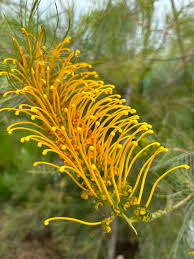Sciencetific Name: Grevillea R.Br. ex Knight
Family Name: Proteaceae
Shrubs, or trees. Leaves sessile or petiolate, entire or toothed, or divided with up to three orders of division; margins flat to revolute, sometimes obscure or absent; venation pinnate-reticulate to parallel. Rowers hermaphroditic, pedicellate or sessile, usually paired, with a common bract, aggregated into conflorescences. Perianth usually zygomorphic with limb decurved, sometimes regular with limb erect. Tepals four, separating after anthesis to release style end. Outer and inner surfaces of perianth glabrous or hairy. Anthers sessile in limb cups of each tepal. Hypogynous glad integral or sometimes angular, rarely absent or 4-merous. Gynoecium (pistil) glabrous or hairy; ovary superior, sessile or stipitate; ovules 2; pollen-presenter erect or oblique to lateral on style, discoid or conical. Fruit a follicle, 2- or 1-seeded, caducous or persistent, glabrous or hairy; pericarp crustaceous to bony-textured. Seeds either peripterous with a usually flat-ellipsoidal seed body, or unwinged ellipsoidal with or without a terminal waxy elaiosome.
Morphology
Fruit a dehiscent follicle; seeds 2. Perianth tubular, expanded distally into a limb enclosing the stamens, the tube splitting on one side to release the style Shrubs or (in Flora area) trees Flowers in short or long simple or branched racemes; bracts caducous Leaves simple or (more commonly in Flora area) pinnately to bipinnately divided
Leaves simple or (more commonly in the Flora area) pinnately to bi-pinnately divided. Flowers in short or long simple or branched racemes; bracts caducous. Shrubs or (in the Flora Zambesiaca area) trees. Fruit a dehiscent follicle; seeds 2. Perianth tubular, expanded distally into a limb enclosing the stamens, the tube splitting on one side to release the style.
